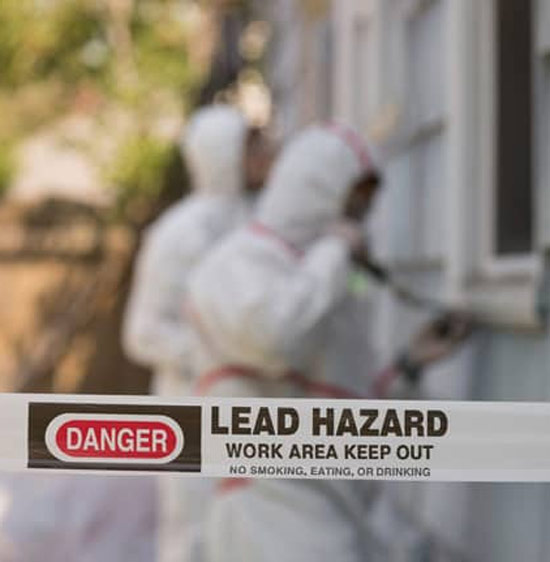NYC Lead Paint Removal Company-- Making Sure Safe and Legal Conformity
NYC Lead Paint Removal Company-- Making Sure Safe and Legal Conformity
Blog Article
Comprehensive Overview on Effective Lead Violation Elimination Techniques
In the realm of environmental safety, attending to lead offenses requires a meticulous and structured method. This thorough guide starts by highlighting the crucial initial steps of recognizing lead dangers via innovative evaluation and testing approaches. The guide elaborates on the relevance of adhering to stringent security procedures throughout the removal process, including the usage of correct PPE and separating influenced locations.
Determining Lead Dangers
Identifying lead dangers is a vital very first action in alleviating the threats associated with lead exposure. Lead, a harmful metal, can be present in various ecological tools, including paint, dirt, water, and dirt.
The initial phase in recognizing lead hazards entails understanding common lead sources within the constructed setting. Structures built prior to 1978 are specifically vulnerable due to the common use of lead-based paint throughout that duration. Additionally, soil contamination can happen from wearing away exterior paint, commercial discharges, or historic use leaded gas.
One more significant source is lead piping and plumbing fixtures, which can leach introduce drinking water. Durable goods such as toys, porcelains, and imported products might likewise contain unsafe lead degrees. Significantly, work-related settings and leisure activities including lead can track contaminants right into homes.
Analysis and Testing
When attending to lead threats, efficient evaluation and testing are paramount. This crucial action ensures the recognition and metrology of lead existence, thereby directing succeeding remediation efforts. Initial assessment usually includes an aesthetic assessment to recognize possible lead resources, such as degrading paint or contaminated dirt. This is matched by even more rigorous testing approaches to identify the extent of contamination.

Dust clean sampling is one more critical technique, especially in household settings. By accumulating examples from floors, windowsills, and various other surface areas, this approach supplies understandings right into potential exposure dangers. Dirt testing around building perimeters is essential to detect lead contamination that can pose risks, specifically to kids.
Safe Elimination Procedures
Upon finishing comprehensive assessment and screening, carrying out risk-free elimination treatments is the following crucial stage in attending to lead dangers. This procedure ensures that lead-contaminated materials are properly and securely gotten rid of, minimizing risk to both employees and homeowners. The very first step involves separating the damaged area using plastic bed linen and correct securing methods to stop the spread of lead dust.
Employees should put on appropriate individual protective equipment (PPE), including respirators, gloves, and disposable coveralls, to reduce exposure. Utilizing specialized tools and wet methods, such as damp sanding or utilizing HEPA-filtered vacuums, reduces the dispersion of lead bits. It is essential to stay clear of dry fining sand or unpleasant blowing up, as these methods can produce unsafe lead dust.
Garbage disposal is an additional essential component; all contaminated materials have to be safely landed and labeled according to EPA and neighborhood laws. Additionally, extensive cleaning of the workspace with HEPA vacuum cleaners and wet wiping makes sure the elimination of residual lead particles.
Post-Removal Verification

Verification of successful lead removal, recognized as post-removal verification, is vital to make sure the safety and habitability of the remediated area. This assessment guarantees that all well-known sources of lead have actually been attended to and that no visible indicators of contamination stay.
Following the aesthetic inspection, environmental tasting is conducted. This entails collecting dust, soil, and often water examples from the remediated location. Recognized laboratories evaluate these samples to determine lead levels, ensuring they fall below the safety limits established by regulatory bodies such as the Environmental Defense Agency (EPA)
In addition, air high quality screening may here be performed to spot airborne lead bits, specifically in cases where extensive lead-based paint elimination or restoration has actually happened. The results of these tests offer quantitative data verifying that the lead levels are within acceptable limits.
Ultimately, post-removal confirmation acts as a crucial checkpoint, validating the efficiency of the lead abatement efforts and securing the wellness of owners and visitors.
Safety Nets and Upkeep

A vital precautionary measure consists of making use of lead-safe licensed professionals for any kind of renovation, repair work, or painting activities. These professionals are trained in techniques that lessen lead dirt and particles. Furthermore, preserving painted surface areas to stay clear of chipping or peeling is necessary, as degrading paint can release lead fragments right into the atmosphere.
Educational initiatives targeting property proprietors and occupants concerning the threats of lead and the value of reporting any possible dangers can even more enhance preventative initiatives. Routine cleansing utilizing HEPA vacuum cleaners and damp mopping strategies can substantially you could try here lower lead dust build-up.
Verdict
In summary, reliable lead infraction removal necessitates a thorough look at this site technique including complete assessment, exact screening, and stringent elimination procedures. Continuous examinations and upkeep are crucial to mitigate future lead risks, consequently securing public health and making certain sustained conformity with regulatory needs.
Report this page